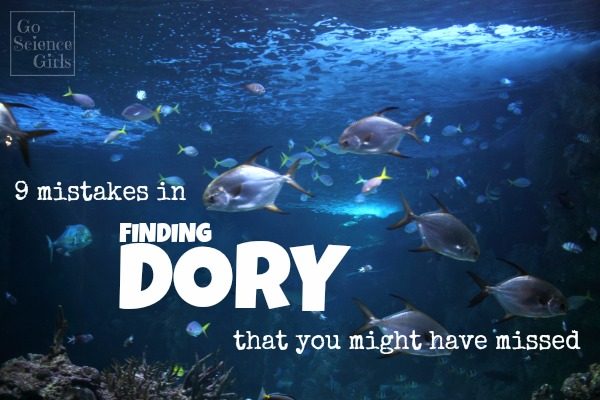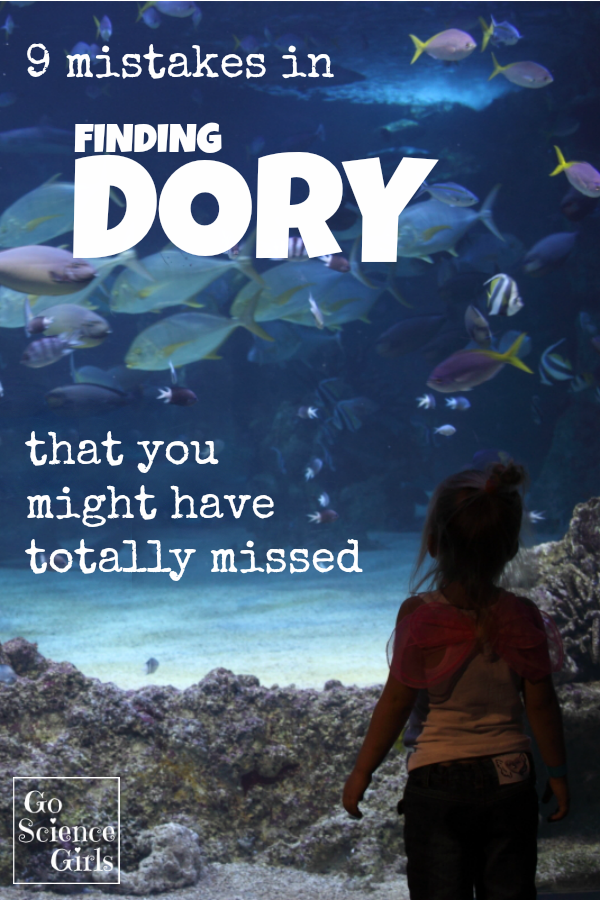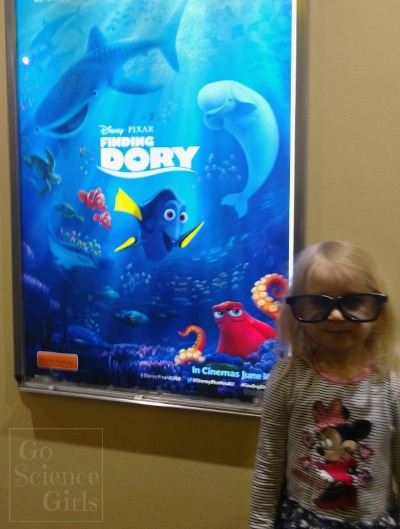The kids and I were treated to an advance screening of Finding Dory yesterday. So exciting to be one of the first to see the new hit movie that everyone’s talking about!

I don’t want to give too much away, but suffice to say that we loved the film. The 3D animation is amazing. There’s a bunch of new, loveable characters, and of course, a few familiar favourites. The storyline is sweet, although it did drag on a bit in the second half while they were trying to build suspense. But, it does have some great messages about believing in people, and working with people’s strengths. I think “What would Dory do?” is going to become my new life motto!
Of course, Finding Dory isn’t a true story. But the characters are based on real sea creatures, the Great Barrier Reef and Morro Bay are real locations and awesome marine aquariums that rescue, rehabilitate and release do exist all over the world. (We have two in Sydney, and love visiting them regularly! Here are our reviews of Sea Life Sydney Aquarium and Manly Sea Life Sanctuary, in case you’re interested.)
One of the things we like to do after watching movies like this, is to speculate whether certain aspects of the movie are possible, and where the movie-makers might have gotten it totally wrong, or in some cases ‘stretched the truth’ a bit to make the story flow better. My kids love these discussions because they’re light-hearted and fun, build on their marine knowledge, and help to clarify things they may be confused about.

9+ Things in Finding Dory that Aren’t Actually Possible
1. Not all water in an aquarium setting is the same. Marine creatures need salt water to live. Some water sources in aquariums (like sippy cups, water fountains, and mop bucket water) would be fresh water from the tap (or possibly chlorinated water), not salt water. So the fish couldn’t have jumped between these different water sources.
2. Whale sharks don’t (and can’t) sound like whales. They are completely different animals, with a completely different anatomy. Whales are mammals whereas whale sharks are fish (indeed, they are the world’s biggest fish). Fish don’t have lungs like mammals do, and so can’t make the same sorts of sounds. (Except lungfish have lungs, but that’s another story…)
3. Whale sharks don’t eat whole dead fish like a seal would. Whale sharks are slow moving filter feeders. They eat teeny tiny food like plankton, krill, floating fish eggs, and other tiny aquatic organisms. They feed in two ways – either by ram feeding, where they open their mouth wide and swim forward, thereby pushing large volumes of water (and the food within it) into their mouth, or by suction feeding, where they open and close their mouth, sucking in large volumes of water. In both cases, the filter pads separate the food from water, and the excess water is expelled through the gills. They wouldn’t eat be fed individual dead fish from a bucket…
4. Whale sharks can’t jump. At least, I can’t find any evidence that anyone has ever seen one jumping. Considering that they are such slow moving creatures, I seriously doubt they could.
5. Echolocation is not the same as x-ray. Beluga whales (and a few other animals, like dolphins and bats) can locate objects by making sounds and listening for echoes, called echolocation. Beluga whales typically use echolocation for navigating under ice fields and finding breathing holes in the ice. Even if a beluga whale could use echolocation in air (which I highly doubt, due to the difference in speed that sound waves travel in air to water), it would still only be able to detect objects in front of it. It would not be able to detect objects on the other side of a mountain, or indeed, inside a truck.
6. Sea creatures don’t actually talk. (My 6 year old asked me to add this one).
7. Aquarium tanks aren’t connected by a series of interconnected pipes. This would be too risky – if one tank became infected, they all would be.
8. Octopus arms regenerate. Which is totally cool. A seven-armed octopus wouldn’t stay that way for long.
9. Octopuses don’t really drink coffee. Although if I were Hank, I would if I could too….
10. Tropical fish couldn’t survive in the colder waters of Morro Bay. As reader Randy Griffith pointed out in the comments below (thanks Randy!), the temperature of the water in Morro Bay is much colder than the water temperature of the Great Barrier Reef. Tropical fish like clown fish (Nemo and Marlin) or blue tangs (Dory and her parents) typically prefer water temperatures around 24-28oC (75-82oF). They can survive in water slightly colder than that, in fact, clown fish do often travel with the current from the Great Barrier Reef to Sydney Harbour, but they die in winter when our water temperatures drop. They certainly couldn’t live in the colder temperatures of Morro Bay. (I looked up the Morro Bay water temperatures today, and it’s only 57oF, and that’s in late June…).
11. Giant squid don’t glow. Remember the scary squid from the shipwreck scene? Firstly, a squid like that would live in deeper waters. And secondly, neither can’t glow in the dark, as they’re not bioluminescent.
We’ve only seen the movie once, so I’m sure there are plenty of other hiccups we’ve missed – please add any you spot in the comments below!

And in case you’re interested, there’s a BIG mistake in the original Finding Nemo too, which is kinda cool. (Nature is so amazing!)
12. Marlin wouldn’t have stayed as Nemo’s Dad for very long. Did you know that a school of clown fish always live in a hierarchy with just one female fish on top. If she dies, the most dominant male changes sex and takes her place. Which means Marlin….
If your kids are interested in marine life, I highly recommend taking them to an aquarium or sea-life sanctuary near you. They are such fascinating places to learn about the wonderful world under the sea. We’ve been to the two near us lots of time, and every time we learn something new. You can see our reviews here:
- Our review of Manly Sea Life Sanctuary (which has the cutest little penguins)
- Our review of Sea Life Sydney Aquarium (which has a pair of dugongs!!)
* Disclosing that we were invited to a non-obligatory, advance media screening of Finding Dory courtesy of Subway Restaurants® (SUBWAY), Disney.Pixar and Digital Parents. This was not a paid post and all opinions are my (or my kids’) own.

#
Tangs, like Dory, and Clown Fish, like Marlin and Nemo, are tropical fish, which is why they live in Australia. Waters, like my home town of Morro Bay, are cold, which makes migration difficult and certainly impossible to live in.
#
Good one!
#
Nemo would have be dead if grabbed by a Humboldt squid
#
Do you mean the scary squid in the shipwreck scene? Yes, I remember that scene now. I did a quick search, and you’re right, there’s some facts wrong there too. Firstly, a squid like that would prefer deeper waters, and secondly, whilst it could change colour between red and white, it wouldn’t be able to glow fluorescent blue like the one in the movie did, because they are not bioluminescent. And thirdly, yes, Nemo would have totally been lunch!
#
The octopus also can’t change colors to fit the background of it self
#
Humboldt squid are among the largest of squids, reaching a mantle length of 1.5 m (4.9 ft). Like other members of the subfamily Ommastrephinae, they possess bioluminescent photophores.
Wikipedia- “Humboldt squid Found in Pebble Beach (2003)”. Sanctuary Integrated Monitoring Network. Archived from the original on 2012-05-07. Retrieved 2011-10-25.
#
Bioluminescence is common among squid. It is estimated nearly two-thirds of all squid genera include bioluminescent species.
http://squid.tepapa.govt.nz/the-deep/article/bioluminescence-in-the-deep-ocean
#
Hank would have died when he inked in the touch pool.
#
I live in morro Bay. The aquarium in the movie is as far from the horrible jail aquarium that we have here. It is more likely Monterey bay aquarium.
#
Oh thanks for letting me know! And that’s so sad to hear that the Morro Bay aquarium isn’t very nice 🙁
#
I know this one may seem obvious but had to post it. The fish would not have lived a year stuck in individual bags like at the very end of the film.
#
thanks for posting – sometimes it’s the obvious ones that are most easily overlooked!
#
Also squids swim backwards, or tentacles first and head last. The one in the movie swims head first.
#
Good one! I didn’t know that!
#
it is an octopus, not a squid, though I still don’t know what species that would be. It has no fins, claws, or clubs.
#
I just thought this would be fun info for everyone, but there actually is a squid that has bioluminescent capabilities. It’s called the Vampyroteuthis, or Vampire Squid. It uses it as a defense mechanism.
#
They’re such an awesome creature, huh. They’re a little bit different to the squid in Finding Nemo though – for one they live in the (very) deep sea, and can’t change their colour. They’re also not actually bioluminescent themselves, but they can eject a sticky cloud of bioluminescent mucus (which is totally awesome)…
#
They also aren’t actually squids, and they’re detritivores.
#
Nemo and marlin in the fish tank with the fake fish, when they see what the cup can do with the shooting water they decide to do the same by jumping out of the tank. Now you will see the fake fish hitting the glass and looking out which gave them the idea and when they jump out…the fake fish is gone. Pause a little after when they are in the air and you’ll see the fish is back and still hitting the glass.
#
Ooh, you’ve been watching closely! Good one!
#
Actually I think it was meant to be a vampire squid, which actually is bioluminescent
#
I thought it was a firefly squid rather than a giant said or a vampire squid. They look exactly like the squid in the film, and they glow for counter illumination camouflage, to attract a mate as well as prey like our little fishy friends… however, firefly squid are only a few inches long…
#
When Hank tells Dory he can’t fit through the pipes, it’s definately a bluff or a mistake. Octopus are known for being able to fit into spaces much smaller than themselves!
#
That is so cool! I noticed the echolocation, the whale shark diet, I don’t really remember if I got the whale shark making whale sounds, and uh obviously the drinking coffee and talking (BTW SO CUUTE!!) But it was really cool to learn all of those, thanks for being awesome, you sound like the type of mom I want to be.
#
I think it’s pretty clear that they did not do the proper research. Then again it’s not like it’s a historical film, it’s a sequel to a kids show. And on those terms, they did great.
#
This is so annoying. What is out with Hollywood and every article writer?
Morro Bay & Monterey are TWO DIFFERENT CITIES. They’re well over an hour apart from each other!
Dory is NOT from ‘Morro Bay’, she’s from Monterey.
MASSIVE difference.